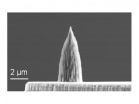(Press-News.org) One of the most promising innovations of nanotechnology has been the ability to perform rapid nanofabrication using nanometer-scale tips. The fabrication speed can be dramatically increased by using heat. High speed and high temperature have been known to degrade the tip… until now.
"Thermal processing is widely used in manufacturing," according to William King, the College of Engineering Bliss Professor at the University of Illinois at Urbana-Champaign. "We have been working to shrink thermal processing to the nanometer scale, where we can use a nanometer-scale heat source to add or remove material, or induce a physical or chemical reaction."
One of the key challenges has been the reliability of the nanometer-scale tips, especially with performing nano-writing on hard, semiconductor surfaces. Now, researchers at the University of Illinois, University of Pennsylvania, and Advanced Diamond Technologies Inc., have created a new type of nano-tip for thermal processing, which is made entirely out of diamond.
"The end of the diamond tip is 10 nm in size," King explained. "Not only can the tip be used for nanometer-scale thermal processing, but it is extremely resistant to wear."
The research findings are reported in the article, "Ultrananocrystalline diamond tip integrated onto a heated atomic force microscope cantilever," that appears in in the journal Nanotechnology. The study shows how the 10 nm diamond tip scans in contact with a surface for a distance of more than 1.2 meters, and experiences essentially no wear over that distance.
"The scan distance is equal to 100 million times the size of the tip," said King. "That's the equivalent of a person walking around the circumference of the earth four times, and doing so with no measurable wear."
"The robustness of these diamond-based probes under such harsh conditions—high temperatures and stresses in an oxidizing environment—is quite remarkable and exceeds anything I've seen with other AFM probes," said Robert Carpick, professor of mechanical engineering and applied mechanics at University of Pennsylvania and co-author on the study. "This level of durability combined with the multifunctionality of a thermal probe really opens up new applications for the AFM."
"We are pleased with the results since they prove once again the superiority of diamond tips to any other types of probe tips when it comes to low wear and resistance to harsh environment," said Nicolaie Moldovan, a scientist at Advanced Diamond Technologies and co-author on the study.
INFORMATION:
The authors on the study are Hoe-Joon Kim, Suhas Somnath, Jonathan Felts, and William King, University of Illinois; Tevis Jacobs and Robert Carpick, University of Pennsylvania; and Nicolaie Moldovan and John Carlisle, Advanced Diamond Technologies Inc.
The article is available online at http://stacks.iop.org/0957-4484/23/495302, Nanotechnology 23 (2012) 495302.
Nanometer-scale diamond tips improve nano-manufacturing
A diamond tip lives forever
2012-11-14
ELSE PRESS RELEASES FROM THIS DATE:
Life and death in a star-forming cloud
2012-11-14
The aftershock of a stellar explosion rippling through space is captured in this new view of supernova remnant W44, which combines far-infrared and X-ray data from ESA's Herschel and XMM-Newton space observatories.
W44, located around 10 000 light-years away within a forest of dense star-forming clouds in the constellation of Aquila, the Eagle, is one of the best examples of a supernova remnant interacting with its parent molecular cloud.
The product of a massive star that has already reached the end of its life and expelled its outer layers in a dramatic explosion, ...
You can be a star -- on science's stage
2012-11-14
The rapid growth in "citizen science" projects during the past decade is enabling more and more science enthusiasts, hobbyists, students and other ordinary people to participate in the excitement of real-world scientific research and help solve serious scientific mysteries. That's the topic of the cover story in Chemical & Engineering News (C&EN), the weekly newsmagazine of the American Chemical Society, the world's largest scientific society.
Deirdre Lockwood, C&EN contributing editor, traces the growth of citizen science from the Audubon Christmas Bird Count of 1900 ...
Television: Chronicle of a death foretold?
2012-11-14
Not only is TV not endangered, but it also has a unifying social impact on the nuclear family across the country. This is the main conclusion of a cross-Canada study—Are the Kids All Right?—on the television viewing habits of families with at least one child aged between 9 and 12 years. The study was conducted by a team of researchers led by André H. Caron, professor of communications at Université de Montréal and Director of the Centre for Youth and Media Studies (CYMS).
"Young Canadians today live in a different world than that experienced by previous generations. In ...
Could poor sleep contribute to symptoms of schizophrenia?
2012-11-14
Neuroscientists studying the link between poor sleep and schizophrenia have found that irregular sleep patterns and desynchronised brain activity during sleep could trigger some of the disease's symptoms. The findings, published in the journal Neuron, suggest that these prolonged disturbances might be a cause and not just a consequence of the disorder's debilitating effects.
The possible link between poor sleep and schizophrenia prompted the research team, led by scientists from the University of Bristol, the Lilly Centre for Cognitive Neuroscience and funded by the ...
World's largest respiratory genetics study launches on World COPD Day
2012-11-14
Researchers from the Universities of Nottingham and Leicester are leading the largest ever study of the genetics relating to lung disease.
The project will investigate what determines an individual's lung health and why smoking harms the lungs of some people more than others and will use health information held by UK Biobank, a major national resource holding health information from half a million volunteers.
The study, funded by the Medical Research Council (MRC) and also involving scientists at St George's, University of London, is aiming to shed light on why some ...
How safe are our roads for Bradley and the nation's cyclists?
2012-11-14
A new government-funded study is to be carried out into how Britain's roads could be made safer for cyclists to reduce the risk of cycling injuries, encourage more people to use bikes and improve public health.
Amid fresh calls for action on road safety after the recent separate accidents involving world-famous cyclist Bradley Wiggins and the top cycling mentor Shane Sutton, researchers at The University of Nottingham are leading a study which will assess the effectiveness of the current cycling infrastructure and ask 'which features installed for cyclists are most effective ...
What lies beneath? New survey technique offers detailed picture of our changing landscape
2012-11-14
A new surveying technique developed at The University of Nottingham is giving geologists their first detailed picture of how ground movement associated with historical mining is changing the face of our landscape.
The new development by engineers at the University has revealed a more complete map of subsidence and uplift caused by the settlement of old mines in the East Midlands and other areas of the country and has shown that small movements in the landscape are bound by natural fault lines and mining blocks.
It appears to support concerns that movement associated ...
Lmod: The 'secret sauce' behind module management at TACC
2012-11-14
It's likely that fellow users on your favorite supercomputer have widely varying needs. The applications, compilers, and libraries that you need are probably different from the ones other users need. That is where modern environment module systems come in. A good module system "sets the table " for users by loading the packages each user needs.
The Texas Advanced Computing Center (TACC) has developed an innovative module system that addresses some unique challenges facing modern computing centers.
Life in the world of computing has become much more complicated since ...
Rare parasitic fungi could have anti-flammatory benefits
2012-11-14
Caterpillar fungi (Cordyceps) are rare parasites found on hibernating caterpillars in the mountains of Tibet. For centuries they have been highly prized as a traditional Chinese medicine - just a small amount can fetch hundreds of pounds.
Scientists at The University of Nottingham have been studying how this fungus could work by studying cordycepin, one of the drugs found in these mushrooms. They have already discovered that cordycepin has potential as a cancer drug. Their new work indicates that it could also have anti-inflammatory characteristics with the potential ...
In financial ecosystems, big banks trample economic habitats and spread fiscal disease
2012-11-14
Like the impact of an elephant herd grazing on grassland, multinational banks shape the financial environment to an extent that far outweighs their small number. And like a contagious person on a transnational flight, when these giant, interconnected banks succumb to financial ills, they are uniquely positioned to infect wide swaths of the financial system.
Researchers from Princeton University, the Bank of England and the University of Oxford applied methods inspired by ecosystem stability and contagion models to banking meltdowns and found that large national and international ...
LAST 30 PRESS RELEASES:
The perfect plastic? Plant-based, fully saltwater degradable, zero microplastics
Bias in data may be blocking AI’s potential to combat antibiotic resistance
Article-level metrics would provide more recognition to most researchers than journal-level metrics
Satiety’s little helper: Protein that supports appetite regulating protein identified
UF dives deep into predicting storm damage with computer models
A stormy ocean voyage yields insights on the global carbon cycle
Scientists identify first non-coding gene that controls cell size
Demonstration of altermagnetism in RuO₂ thin films -- A new magnetic material for the AI era
Penn researchers awarded $25M to conduct trial using smartphones to fight heart disease
PCORI awards funding for new patient-centered healthcare research
Exploring the origins of the universe: 145 low-noise amplifiers complete ALMA telescopes
Empress cicada wings help illuminate molecular structure
Using sound waves to detect helium
Time burden in patients with metastatic breast and ovarian cancer from clinic and home demands
Researchers discover bias in AI models that analyze pathology samples
Scientists ID potential way to prevent brain injuries from triggering Alzheimer's
MASTER 2nd Open Call: Execution period kick-off
Algae for health in food and pharma
Advanced microrobots driven by acoustic and magnetic fields for biomedical applications
Chicago health information leader recognized for raising CPR readiness and blood pressure awareness
The Intimate Animal, a new book from Kinsey Institute Executive Director Dr. Justin Garcia
When blue-collar workers lose union protection, they try self-employment
New video dataset to advance AI for health care
MEA-based graph deviation network for early autism syndrome signatures in human forebrain organoids
New modeling approach sheds light on rare gut disease
Study documents potentially hazardous flame retardants in firefighter gear
Can certain bacteria regulate aging of the immune system and its related alterations?
AI model helps diagnose often undetected heart disease from simple EKG
There are fewer online trolls than people think
Cell membrane fluctuations produce electricity
[Press-News.org] Nanometer-scale diamond tips improve nano-manufacturingA diamond tip lives forever


